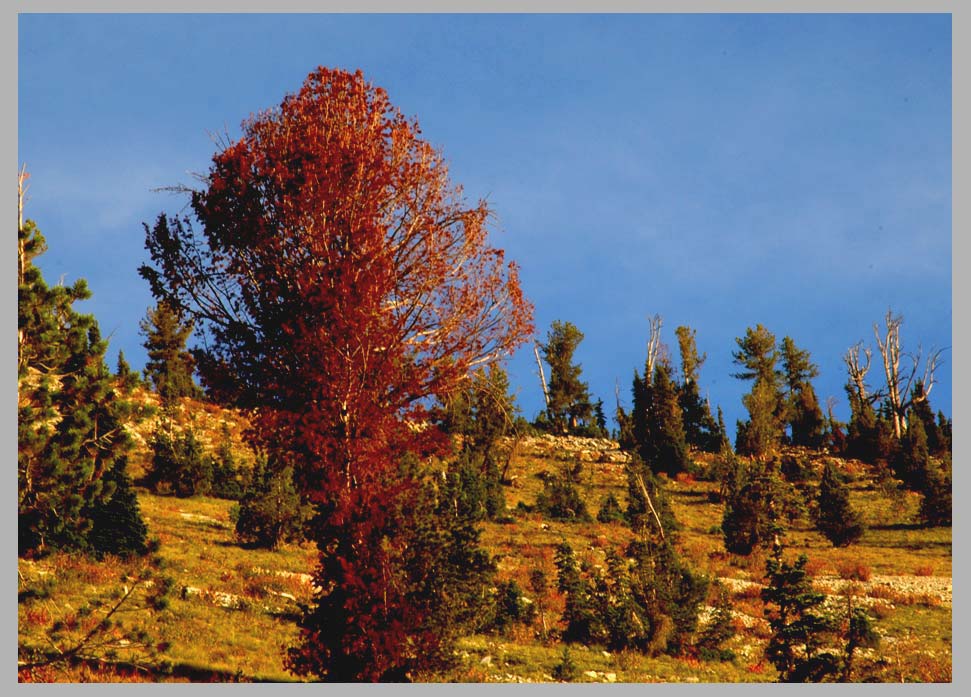

Marker Stonepine—Whitebark Pine, dieback or collapse? (Pinus albicaulis)
Eagle Cap Wilderness [click photo for next . . . ]


Marker Stonepine—Whitebark Pine, dieback or collapse? (Pinus albicaulis)
Eagle Cap Wilderness [click photo for next . . . ]
WHITEBARK PINE COLLAPSE?
What we mean by GROWTH needs to shift
from the explosive runaway of compound interest,
to the sure, steady, cyclical rhythms
of a Stonepine.
This is a color & form to learn. The sad rusty-red of dying Whitebark Pines
stands out on high slopes and ridges at a distance of more than 1000 meters.
I use them as crosscountry guideposts, hence, the epithet "marker."
Whitebark Pines are in trouble around the mountains
of the Northwest. For me, they have become a sentinel species
because they are not only the grandest and, in my view, most
powerful of pines to reach the upper limits of treeline—even
in death the sun-bleached white snags stand tall for centuries—
but also, like wounded watchful elders, the Nestors of the
high-country, they are sounding a dire message of warning.
In the Alps, a related species of stonepine, Pinus cembra, is
an object of much veneration and folklore. Just the act of an
old mountain farmer saying its name in dialect, Arve, seems
to fill him with a kind of primeval religious awe. Indeed, it
has for hundreds of years been the favored wood for carving,
and remarkably, for works of Art which show when seen within
the traditional European cultural categories both sacred and
profane aspects, ie., both crucifixes & 'wildman' masks for
mountain carnival, Fastnacht.
I mention this only because I am repeatedly reminded that no
similar tradition, as far as I know, exists in North America.
Perhaps that is why only a handful of dedicated scientific
researchers seem to be listening seriously to what the Whitebarks
are saying, and not the culture at large. For as always—and this
is sad to say, and is of course only my own opinion—North American
culture is largely indifferent, is largely uninformed by the
spirit of its great mountains.
Perhaps that is why I feel somehow compelled to mark in image
and word as many of the sick stonepines as possible that I
meet along the way.
I've also started a new collection of linked online resources,
mostly short and informative streamed documentaries, at:
http://picture-poems.com/whitebarks
p/p DIALOGUE PAGE | WHITEBARK PINE COLLAPSE
Robert Keane, showing me his book,
Whitebark Pine Communities:
Ecology and RestorationFrom another Of Robert Keane's publications,
RAPID DECLINE OF WHITEBARK PINE
IN WESTERN MONTANA: EVIDENCE FROM
20-YEAR REMEASUREMENTS
"Whitebark pine (Pinus albicaulis), an important producer
of food for wildlife, is decreasing in abundance in western
Montana due to attacks by the white pine blister rust fungus
(Cronartium ribicola), epidemics of mountain pine beetle
(Dendroctonus ponderosae) and successional replacement
mainly by subalpine fir (Abies lasiocarpa). Plots established
in 1971 were remeasured in 1991 and 1992 to determine the
rate and causes of whitebark pine mortality. Mortality rates
averaged 42% over the last 20 yr. indicating a rapid decline in
whitebark pine populations of western Montana. This decline
is most pronounced in northwestern Montana with the southward
extension of heaviest mortality centered along the continental
divide and Bitterroot Mountain range. Management treatments
such as prescribed fire can serve to maintain whitebark pine
in the landscape."
My good friend, field biologist
David Landrum, gives me
a lesson in MOUNTAIN PINE
BEETLES (North Wallowas)Skeleton Whitebark forest
in Glacier National Park
| see also: Whitebark Pines: Endangered Sentinel for a collection of more images |
WHITEBARK PINE—resources
(1) Whitebark Pine Health in Northeastern Oregon
and western Idaho (Chrales Johnson 1998) [pdf]
(2) EarthFix: Scientists Scramble to Save Crater Lake's
Whitebark Pines, by Amelia TempeltonWHITEBARK PINE—8 key ecological
features (after Charles G. Johnson)
(1) Of little commercial value for timber products.
(2) Distribution and abundance of the species dependent on Clark's
nutcracker for seed dispersal.
(3) Fire resistant due to its severe site and scattered nature (fire
discriminates against subalpine firs giving competitive advantage
to the pine).
(4) Fire control lengthens intervals between sanitizing burns resulting
in fire-prone stands due to increases in fir composition.
(5) Very susceptible to white pine blister rust and secondarily to
mountain pine beetle after weakening by the rust.
(6) Besides Clark's nutcracker, woodpeckers, chickadees, nuthatches, finches, crossbills, grosbeaks and blue grouse
use the seeds. Squirrels, chipmunks and bears use the caches.
(7) Blue grouse use needles and buds.
(8) Greatest value of the tree is for watershed protection.
data from the essential classic, Alpine and Subalpine Vegetation
of the Wallowa, Seven Devils and Blue Mountains [pdf 8.4 Mb]
By Charles Grier Johnson Jr.
2004 USDA- Forest Service Pacific Northwest Region
THE LITTLE CLAVIER please preview 150 of 631 pages
w/ my black & white photography [opens in new window]
Follow @cliffcrego
DEATH OF A FOREST
by Wild Visions,
Excellent interview of leading exert,
Dr. Jesse Logan;
Gives best overview of scale & seriousness
of forest collapse problem . . .
